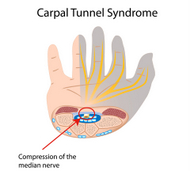The Nervous System - When It Hurts, It Really Hurts
What Is The Nervous System?
It is composed of nerve cells, called neurons, which control the voluntary and involuntary movements of the body by sending signals of a chemical or electrical nature.
The signals between neuron cells in the nervous system are rapidly sent in the form of electrochemical sparks along axons to connections between cells and at that point of juncture the neurons release neurotransmitters which affect the receiving cell and it then responds to the message contained in the chemical.
However, these nerve cells, neurons, are not easily replaced if they become damaged or die. There are many diseases of the nervous system and these include, but are not limited to, Multiple Sclerosis, Epilepsy and Parkinson's Disease.
The Parts of The Whole
There are three forms:
The Central system contains the brain and spinal cord,
The Peripheral system which connects the rest of the body and
The Autonomic which directs the breathing, heart and digestive systems.
The Nervous System "Breakdowns"
Sciatica
The sciatic is a bundle of nerves within the nervous system which originates in the lower spine. This bundle joins together and radiates from the spine down the back of each leg, through the buttocks to the foot. It controls sensation and function to the leg, down to the foot.
Symptoms of Sciatica
Typically sciatica is only felt on one side of the body at a time.
The sensation is one of tingling in the leg, or numbness, or pins and needles, perhaps a constant pain in one side of the buttock or back of the leg. Or it could be a shooting pain down the rear of one leg, or maybe a weakness in standing up.
You may feel a pain in the buttocks or legs when lifting heavy objects or a general weakness in the muscles of the lower body.
It will be different for every person and will depend on the cause.
Mostly the sciatica reaction will be temporary and the pain or discomfort will resolve itself quite quickly – for example you may have just pinched a nerve while sitting in an awkward position, which rights itself when you move about.
As we age our lumbar spine does tend to degenerate so sciatic pain is more common in the elderly.
If the pain is persistent it is best to get it checked. However, there are some remedies which can help mild situations – get some gentle exercise like swimming as it’s not weight bearing, putting ice packs on the lower spine can reduce the inflammation, rest the lower back in a comfortable but ergonomic chair or bed, or relax in a warm bath.
Conditions Causing Sciatica
One of the most common conditions which can cause sciatic pain is a herniated intervertebral disc –this is when the soft lining of the disc bulges out and puts pressure on the nerve.
Spondylolisthesis is where one disc slips over the next one and can compress the nerve. This condition is usually caused by degenerative conditions of the spine, like arthritis.
Bone spurs or osteophytes are formed when cartilage wears away and bone is rubbing on bone. This allows them to irritate local nerves and if this is located in the lower spine then it could be the sciatic nerve which is affected.
Sciatica Recipe One
Ingredients:
- 10 drops Lavender essential oil
- 10 drops Thyme essential oil
- 10 drops Chamomile essential oil
- 30ml Sweet Almond oil
Directions:
Mix all ingredients together and massage the lower spine and buttock area to relieve symptoms.
Sciatica Recipe Two
Ingredients:
- 3 drops Geranium essential oil
- 3 drops Marjoram essential oil
- 3 drops Rosemary essential oil
- 1 drop Pine essential oil
- 3 tablespoons Sweet Almond oil
Directions:
Mix all ingredients together and massage into buttocks and legs.
Carpel Tunnel Syndrome

Carpel tunnel syndrome is where the median nerve traveling through the carpel tunnel in your wrist is trapped and pinched causing pain and numbness. Only the thumb, index and middle fingers and part of the third finger are affected as they are the only ones controlled by the median nerve. Carpel Tunnel is only one of many repetitive strain type nervous system disorders usually associated with office workers or people using their hands in a repetitive manner. RSI or Repetitive Strain Injury, Cumulative Strain Disorder and Occupational Overuse Syndrome are other terms used for similar conditions.
Symptoms of Carpal Tunnel
The symptoms of carpel tunnel syndrome are when the hand feels tingly, numb, sort of a prickly sensation. It often first manifests at night time but with worsening conditions the symptoms may continue during the day.
Causes of Carpal Tunnel
Causes can be varied, maybe a congenital disorder, or a result of trauma or injury to the wrist, or perhaps rheumatoid arthritis. There could be other causes – it is best to see a doctor of a complete diagnosis.
Effects of Carpal Tunnel
It can certainly affect strength in the hand, causing a lack of being able to make a fist or grab objects with that hand. Sometimes even the sense of temperature is lost so sufferers are unable to tell if the hand is hot or cold. It seems women are more susceptible than men to carpel tunnel. Reasons could be the size of our hands – meaning the opening in the tunnel is smaller. Chronic symptoms of this nervous system problem can lead to permanent damage and reduced mobility of the hand. Extreme cases lead to surgery.
Rest of the hands should be immediate and gentle exercise to increase mobility should begin under supervision.
If you feel you may have Carpel Tunnel syndrome diagnosis should be sought as soon as possible. Once diagnosed you can confidently use essential oils for this nervous system disorder.
Carpel Tunnel Recipe One
Ingredients:
- 10 drops Rosemary essential oil
- 10 drops Peppermint essential oil
- 10 drops Eucalyptus essential oil
- 30mls Sweet Almond oil
Directions:
Massage of the forearm and wrist can be helpful as well.
Massage up towards the heart from the wrist.

Carpal Tunnel Recipe Two
Ingredients:
- 10 drops Marjoram essential oil
- 10 drops Lavender essential oil
- 10 drops Eucalyptus essential oil
- 30mls Sweet Almond oil
Directions:
Massage the wrist and forearm, all the way up to the shoulder. Work in an upwards motion from wrist.
Neuralgia
Neuralgia is pain in a damaged nerve of the nervous system. It is not usually a disorder in its own right, rather a symptom of another problem.
Forms of Neuralgia
Trigeminal Neuralgia:
This is the most common form of neuralgia. It is a sudden shooting pain in the face, usually only one side at a time. The lightest touch can be agonizing.
Women over the age of 50 are the most affected by this form of neuralgia.
Occipital Neuralgia:
This is caused by the main nerve which runs from the back of the skull up the head becoming inflamed. This causes dull, throbbing headaches or pain in the back of the head, sometimes traveling to the forehead.
The pain can be due to trauma or compression of the Occipital nerve. Causes can be from disease such as osteoarthritis, gout, diabetes, tumors or damage to the cervical discs. It can even be an unknown cause.

Causes of Neuralgia
Causes can be from an infection like Shingles or disease such as diabetes or multiple sclerosis, or from disc damage due to trauma.
Symptoms of Neuralgia
It is a localized pain, in extreme cases often agonizing when touched, with the pain either a burning or stabbing sensation.
Neuralgia Recipe One
Ingredients:
- 10 drops Peppermint essential oil
- 10 drops Eucalyptus essential oil
- 10 drops Marjoram essential oil
- 30ml Sweet Almond oil
Directions:
Mix these oils together and massage into the painful nerves. Repeat daily and for as long as necessary.
Neuralgia Recipe Two
Ingredients:
- 5 drops Lavender essential oil
- 5 drops Chamomile essential oil
- 2 drops Clove essential oil
- 1 dessertspoon Sweet Almond oil
Directions:
Mix these oils together and massage into the painful nerves. Repeat daily and for as long as necessary.
Neuralgia Recipe Three (Facial Nerves)
Ingredients:
- 5 drops Lavender essential oil
- 5 drops Chamomile essential oil
- 1 dessertspoon Sweet Almond oil
Directions:
Mix these oils together and massage into the painful nerves of the face. Repeat daily and for as long as necessary.